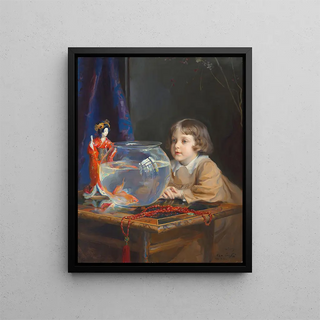Art print | John de László and a goldfish bowl - Philip Alexius de László Source: Reproduction | John de László et un bocal à poissons rouges - Philip Alexius de László


View from behind

Frame (optional)
In the world of art, some works transcend their era and capture the very essence of beauty and reflection. The art print John de László and a goldfish bowl - Philip Alexius de László belongs to this tradition. This painting, evoking an atmosphere that is both serene and dynamic, invites the viewer to immerse themselves in a universe where nature and domestic life blend harmoniously. Through a palette of vibrant colors and a carefully orchestrated composition, the artist offers us a window into a reality that is both familiar and poetic, where every detail seems to tell a story.
Style and uniqueness of the work
Philip Alexius de László's work is distinguished by its unique style, combining realism and impressionism. In this depiction, the goldfish bowl becomes the focal point, immediately drawing the eye. The fish, with their bright hues, seem to dance with the movements of the water, while the luminous reflections create an almost magical atmosphere. The way the artist plays with light and shadow adds a striking depth to the scene, making each element almost tangible. The textures, whether of the smooth glass surface or the delicate scales of the fish, are rendered with remarkable finesse, demonstrating exceptional craftsmanship. De László succeeds in capturing not only visual beauty but also the emotion evoked by this simple scene of everyday life.
The artist and his influence
Philip Alexius de László, born in Hungary and mainly active in England, was a renowned portraitist whose work influenced many artists of his time. His ability to grasp the personality of his subjects while incorporating elements of their environment is one of the reasons he is so respected in the art world. By exploring themes such as nature, domestic life, and intimacy, de László established a dialogue between the viewer and the work, making each painting accessible and touching. His innovative approach and keen sense of detail have left an indelible mark on the artistic landscape, inspiring

Matte finish

View from behind

Frame (optional)
In the world of art, some works transcend their era and capture the very essence of beauty and reflection. The art print John de László and a goldfish bowl - Philip Alexius de László belongs to this tradition. This painting, evoking an atmosphere that is both serene and dynamic, invites the viewer to immerse themselves in a universe where nature and domestic life blend harmoniously. Through a palette of vibrant colors and a carefully orchestrated composition, the artist offers us a window into a reality that is both familiar and poetic, where every detail seems to tell a story.
Style and uniqueness of the work
Philip Alexius de László's work is distinguished by its unique style, combining realism and impressionism. In this depiction, the goldfish bowl becomes the focal point, immediately drawing the eye. The fish, with their bright hues, seem to dance with the movements of the water, while the luminous reflections create an almost magical atmosphere. The way the artist plays with light and shadow adds a striking depth to the scene, making each element almost tangible. The textures, whether of the smooth glass surface or the delicate scales of the fish, are rendered with remarkable finesse, demonstrating exceptional craftsmanship. De László succeeds in capturing not only visual beauty but also the emotion evoked by this simple scene of everyday life.
The artist and his influence
Philip Alexius de László, born in Hungary and mainly active in England, was a renowned portraitist whose work influenced many artists of his time. His ability to grasp the personality of his subjects while incorporating elements of their environment is one of the reasons he is so respected in the art world. By exploring themes such as nature, domestic life, and intimacy, de László established a dialogue between the viewer and the work, making each painting accessible and touching. His innovative approach and keen sense of detail have left an indelible mark on the artistic landscape, inspiring






